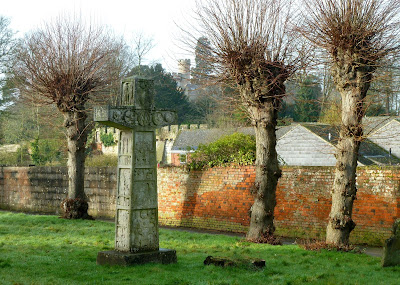I seem to be chasing JS Bach around Wiltshire! Life has been rather quiet since the choral workshop all day last Saturday. Singing for six hours is somewhat exhausting, and on Sunday I did very little, except nibble biscuits and watch simple programmes on the television, with my reclining chair tilted back to an almost bed like position. I was weary, and had every intention of being bone idle for the whole day.
By Monday I was awake again, and took a short walk in the morning, just before the rain set in and stayed for the rest of the day. On Tuesday afternoon I went to the cinema to see "Quartet," an enchanting film about a smart retirement home for elderly musicians, all of whom had seen better days. The dialogue was sharp, and a group of mature actors portrayed the stylish, elderly musicians with their assortment of ailments and idiosyncrasies to a T. The film included excerpts from opera and various pieces of classical music, which in the "surround sound" of a large cinema, sounded wonderful. It is a film worth seeing. The photo above shows Celia walking up the steps to Marlborough College Chapel, the venue of last night's organ recital. Every year the college gives free recitals for those with an interest in organ music, and they provide an opportunity for the music staff and young organ scholars to perform in public.
This slightly fuzzy photo of the chapel, shows centre, last night's organist, as he prepared to play works by JS Bach (my man,) Samuel Wesley, Herbert Howells, Olivier Messiaen and Charles-Marie Widor. The recital began with Bach's Fantasia and Fugue in G minor, which sent me into raptures of delight. How did this man live with such music in his head. His every hour must have been filled with the sound of music coursing through his head.
Olivier Messiaen's "Joie et Clarte des Corps Glorieux No. 6" was the one unorthodox piece in the programme, with many discordant sounds, but with some definite shape to the music. He has been referred to as the composer who writes "wrong note" music, but when heard live, his sounds bombard your senses with vibration and emotion. What I may have disregarded when heard on the radio, became a living being when played before my very eyes and ears.
The present chapel organ is the sucessor to the college's first organ installed in 1876 by Forster and Andrews of Hull. It was enlarged and modernised many times between 1914 and 1988, but by 2005 it was becoming an increasingly unsatisfactory instrument to play.
A new organ was commissioned, and because no British company could be found to install a new instrument, after much searching the contract went to "Von Beckerath of Hamburg." The organ blends with north German traditions, the French Symphonic School and with the great Victorian era of British organ building. The pipes from the original organ were not replaced, as it was felt that their tonal quality could not be improved upon. The new organ was dedicated at a Festal Evensong on February 4th 2007 by the Bishop of Salisbury, with an opening recital given by Simon Preston.








.JPG)


















.JPG)










